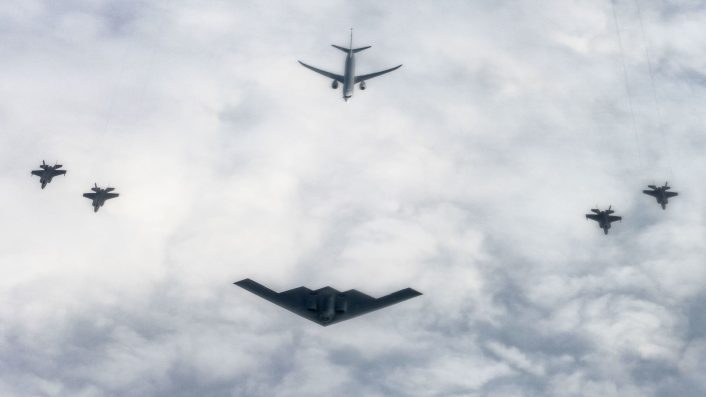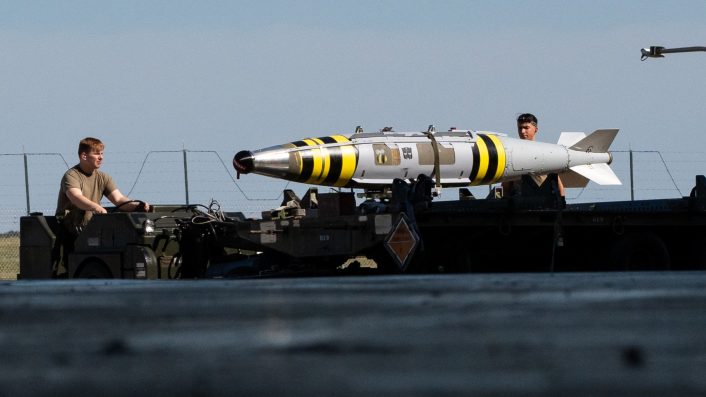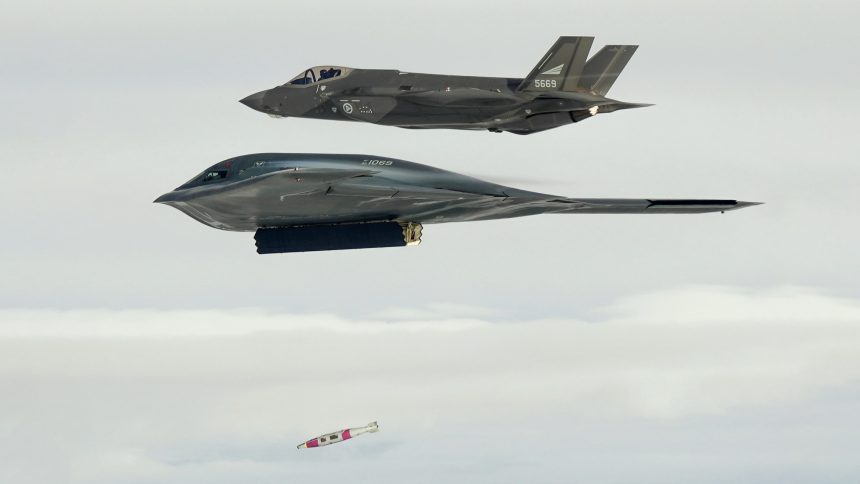The stealth bomber demonstrated a long-range precision maritime strike in the Norwegian Sea using the QUICKSINK weapon.
A U.S. Air Force B-2 Spirit stealth bomber took part in the third demonstration of the QUICKSINK capability, releasing the JDAMs (Joint Direct Attack Munition) modified for maritime strike on a mock target in the Norwegian Sea. The mission, which was conducted on Sep. 3, 2025, saw the bomber accompanied by four Royal Norwegian Air Force (RNoAF) F-35As and a P-8A Poseidon.
The mission was announced by both services a week later, on Sep. 9, 2025. While in the High North, the aircraft were refueled by a KC-135 Stratotanker from the 100th Aerial Refueling Wing (ARW) based at RAF Mildenhall.
However, the flight of the B-2 near Norway was already noted. In fact, on Sep. 3, a B-2 with the callsign “CULT71” was heard communicating with air traffic control on its way to Norway.
B-2 #CULT71 eastbound over the Atlantic out of Whiteman AFB, checking in with Shanwick Radio HF 10021. pic.twitter.com/TVJ2mUGCjo
— EISNspotter 🇮🇪 (@EISNspotter) September 3, 2025
The photos show that preparations went forward for days, with crews from the 509th Munitions Squadron, 393rd and 509th Bomber Generation Squadron and the 72nd Test and Evaluation Squadron assembling and loading the weapons on Aug. 26 and Aug. 28 at Whiteman AFB, Missouri. At least two GBU-31s and twelve GBU-38s were seen in the photos on weapon trailers, ready to be loaded on the B-2.
🇺🇸 2,000-pound class GBU-31 JDAMs (QUICKSINK variant) are prepared, inspected and loaded onto a B-2A Spirit stealth bomber at Whiteman Air Force Base, Missouri, Aug. 28, 2025.
(📸/U.S. Air Force photos by Staff Sgt. Joshua Hastings) https://t.co/zcCKjiKo0Q pic.twitter.com/rS2s2zaFNN
— Guy Plopsky (@GuyPlopsky) September 9, 2025
The weapons build operations were a “component of the AFRL QUICKSINK Joint Capability Technology Demonstration,” the captions said. It is unclear how many weapons were employed in the test.
The first QUICKSINK demonstration from a B-2 took place in the 2024 edition of the RIMPAC (Rim of the Pacific) exercise with a 2,000 pound GBU-31/B JDAM. Then, in April 2025, the AFRL (Air Force Research Laboratory) conducted a test of a “new, more versatile variant of the QUICKSINK maritime weapon,” based on a 500 pound GBU-38 JDAM, employed by a B-2 at Eglin AFB’s Gulf Test Range.

QUICKSINK and B-2
The AFRL confirmed in 2022 that it developed a dedicated seeker for the QUICKSINK role. Interestingly, the two GBU-31 JDAMs are colored differently – one with a pink body, and the other with yellow and black bands in the front and the aft section.
The reason for the different color is unknown, however the pink one was shown in photos by the RNoAF shortly after being released by the B-2. Considering that the photos appear to show two different explosions, it is possible the two GBU-31s were the only ones to be dropped on target.
The captions said the JDAMs were used for the QUICKSINK Joint Capability Technology Demonstration, described as “a new low-cost, air-delivered capability for defeating maritime threats.” The targets were located in the waters of the Norwegian Sea, off Andøya in Nordland.

A B-2 can carry a whopping 80 500 pound-class GBU-38s or 16 2,000 pound-class GBU-31s in a single sortie. Mixed loads are also possible, considering both GBU-31s and GBU-38 were shown being prepared.
The B-2 used for the test is assigned to the 72nd TES, under the 53rd Wing at Eglin AFB, Florida. The 53rd Wing’s press release said the test “also advanced the development of both large and small variants of the precision strike system under evaluation, expanding operational options for commanders in maritime-focused operations.”
The statement appears to refer to the modifications to both the GBU-31’s and GBU-38’s JDAM kit and seeker for the QUICKSINK mission. However, the only photo available shows the GBU-31 being released, while no photos of the GBU-38 being employed are available.

The exercise
The 53rd Wing said it integrated the U.S. B-2 Spirit into a “long-range strike scenario demonstrating seamless cooperation and interoperability to defeat a surface vessel in a realistic setting.” The Luftforsvaret confirmed the participation of its four F-35As and the single P-8A in the “very successful” test.
“To accomplish the mission, capacities from, among others, the Norwegian Navy and Andøya Space were also used,” added the statement.
The 53rd Wing described the drill as a test of next-generation precision maritime capabilities. The unit also said that, in partnership with Royal Norwegian Air Force F-35s and personnel, the test demonstrated “seamless cooperation and interoperability to defeat a surface vessel in a realistic setting.”
“This test is a clear example of how we work with trusted allies to bring new capabilities into play faster and smarter,” 53rd Wing commander Col. Scott Gunn said.
View this post on Instagram
The participation of the Norwegians to the test, beside allowing the U.S. “critical infrastructure and airspace,” also helped refining “advanced tactics, techniques, and procedures for long-range sensor-to-shooter operations,” with common airframes like the F-35A and the P-8A, according to the USAF.
The Lightning II would provide aerial electronic surveillance and an armed escort in the strike package, while the P-8A scans, locates, tracks sea targets and relays the data to the B-2. This is in line with the exercise integrating beyond-line-of-sight communications and multi-domain targeting, as mentioned by the 53rd Wing.
“We are building readiness on both sides of the Atlantic and [making] maritime strike more distributed, survivable, and integrated,” said 72nd TES commander Lt Col. Stephen Bressett.
View this post on Instagram
Future
Questions however remain on the overall strategic efficacy and utility of using B-2 Spirits for striking ships with guided bombs. For one, the JDAM bombs, with ranges expected to be between 45 and 55 miles, nowhere offer the massive standoff distances of dedicated anti-ship missiles like the AGM-88 Harpoon or the AGM-158C LRASM.
The advantage is that the B-2 Spirit’s stealth allows it to get closer to the target with a very low chance of detection. The JDAM’s lack of an active seeker and low infrared signature would also leave little trace for surface-to-air radar and missile sensors to lock on.

Lastly, naval powers like Russia or China would be operating with a full flotilla, their own naval air arm, and backed by land-fired, coastal defense standoff ship-killing missiles. B-2 bombers on the other hand would be outsized for such a tactical strike, and more suited for hitting larger, strategic targets on land with conventional and non-conventional weapons.
Quicksink bombs could be most effective for hitting smaller civilian-based vessels that the PLA Navy is expected to press into service, as had been seen with Z-10 attack helicopters operating from a semi-submersible merchant vessel last October. These free up the bigger Allied warships, multirole aircraft, Harpoons and LRASMs for targets that demand higher-end capabilities.
The Chief of the AFRL’s Munitions Directorate, Col. Matthew Caspers, had previously offered the doctrinal concept behind B-2 Spirit employing the new weapon: “QUICKSINK is the result of a Joint collaboration that rapidly prototyped an affordable concept for holding surface targets at risk.”









